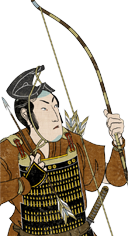
Basic Unit Statistics (can be modified by difficulty level, arts, skills, traits and retainers)
| Upkeep Cost | 0 | |
| Melee Attack | 2 | 5% |
| Charge Bonus | 1 | 2% |
| Bonus vs Cavalry | 0 | 0% |
| Range | 150 | 23% |
| Accuracy | 15 | 15% |
| Reloading Skill | 20 | 20% |
| Ammunition | 25 | 31% |
| Melee Defence | 1 | 2% |
| Armour | 1 | 6% |
| Morale | 3 | 6% |
Strengths & Weaknesses
- Low accuracy and reload rate.
- Low morale.
- Large unit size.
- Vulnerable to cavalry.
- Weak against higher quality troops.
Abilities
- Flaming Arrows - This unit can fire flaming arrows for a short period of time. Flaming arrows have a greater damage effect and can set fire to flammable objects. Flaming arrows don't function in wet weather.
- Screens - A shield that can be erected during the deployment phase when you are defending. It impedes the movement of enemies, and blocks enemy projectiles.
Description
These light infantry archers are used to screen a front line, and harass enemies with long range arrow volleys.
Levies do not possess the prowess or prestige of samurai but they are still a formidable force. The numerical size of this unit allows it to provide mass fire support. Once hand-to-hand fighting starts bow levies should retreat to safety behind the battle line, as they are not trained or equipped for melee. They must also be wary near cavalry, as they have little chance of survival when charged by horsemen. Japanese bows at the time of the Gempei War can generally be classified as "long bows" although they differ in a number of ways from their European counterparts. The most obvious difference was the position of the grip, but they were also "composites", made from several different materials, rather than "self-bows" made from a single piece of wood. The bows had to be long to generate power but if the grip had been central it would have been impossible to use the bow from horseback. The lower section would always become entangled with the horse or the saddle. By moving the grip downwards, the asymmetric design allowed the bows to be used easily by mounted archers while keeping them enormously powerful.